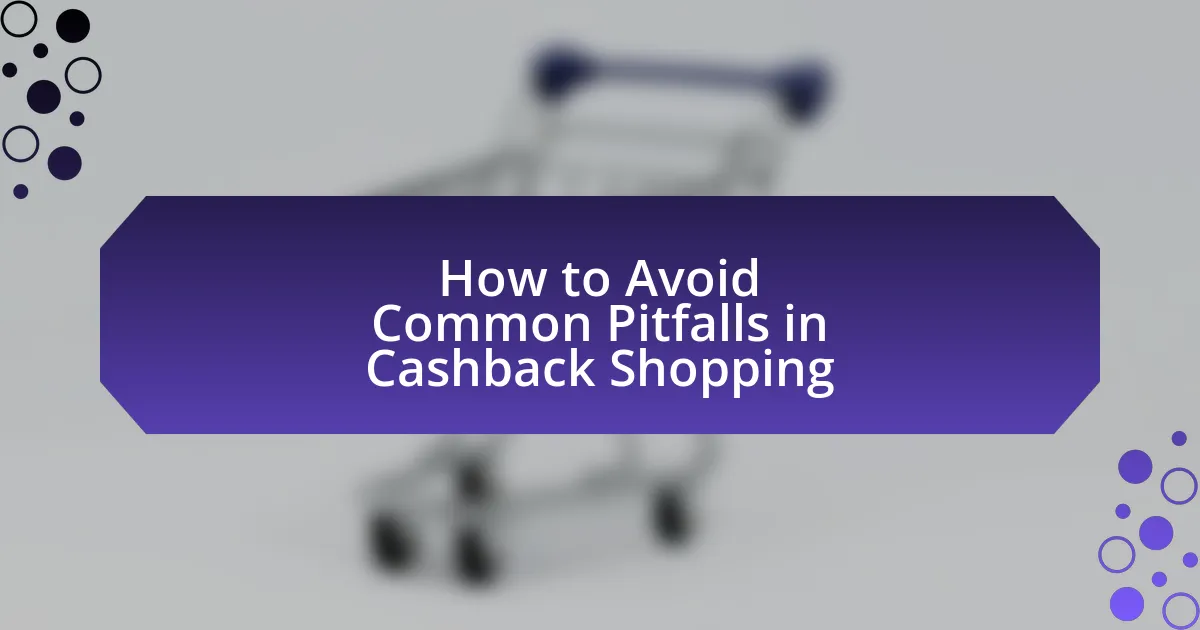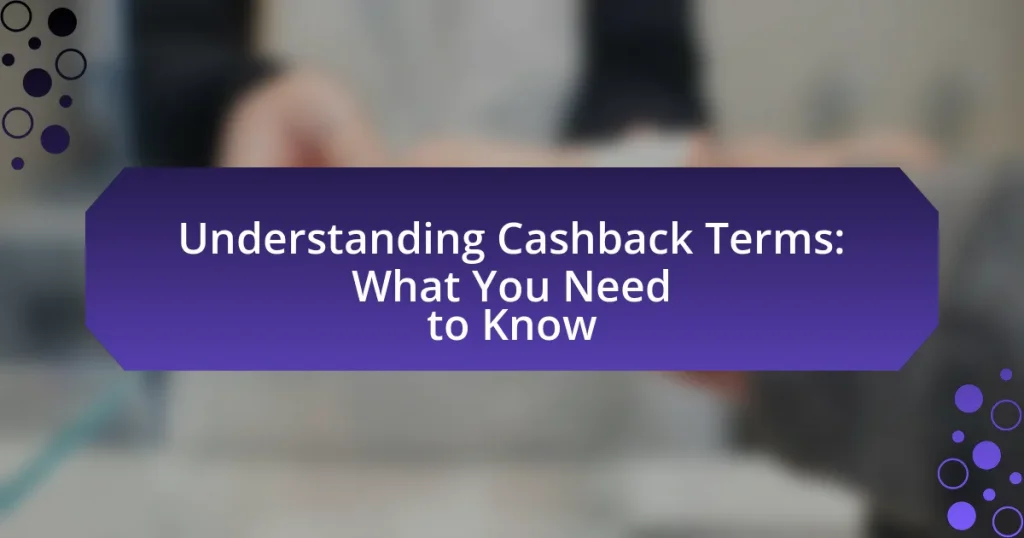The article focuses on how to avoid common pitfalls in cashback shopping, highlighting key issues such as overlooking terms and conditions, failing to track expiration dates, and neglecting to compare cashback rates across platforms. It examines the reasons shoppers fall into these traps, including a lack of awareness and impulsive buying behavior influenced by psychological factors. Additionally, the article discusses marketing tactics that can mislead consumers and outlines best practices for maximizing cashback benefits, such as thorough research, strategic planning, and utilizing various tools and resources. By understanding these elements, shoppers can enhance their cashback shopping experience and avoid costly mistakes.

What are the common pitfalls in cashback shopping?
Common pitfalls in cashback shopping include overlooking terms and conditions, failing to track cashback expiration dates, and not comparing cashback rates across platforms. Overlooking terms and conditions can lead to missed opportunities, as many cashback offers have specific requirements that must be met to qualify. Failing to track expiration dates can result in losing earned cashback if not redeemed in time; for instance, some cashback offers expire within a few months. Additionally, not comparing cashback rates can lead to choosing a less favorable option, as rates can vary significantly between different cashback websites or apps.
Why do shoppers fall into these pitfalls?
Shoppers fall into pitfalls in cashback shopping primarily due to a lack of awareness and understanding of the terms and conditions associated with cashback offers. Many consumers do not fully read the fine print, leading to misunderstandings about eligibility, expiration dates, and the specific requirements needed to qualify for cashback. Research indicates that approximately 70% of shoppers overlook critical details in promotional offers, which can result in missed opportunities for savings. This lack of attention to detail often stems from the overwhelming number of deals available, causing shoppers to make impulsive decisions without adequate information.
What psychological factors influence cashback shopping decisions?
Psychological factors influencing cashback shopping decisions include perceived value, loss aversion, and social proof. Perceived value drives consumers to seek cashback offers as they believe they are receiving a better deal, enhancing their shopping experience. Loss aversion, a principle from behavioral economics, suggests that consumers are more motivated to avoid losses than to achieve gains; thus, the idea of getting money back can be more appealing than a simple discount. Social proof also plays a role, as consumers may be influenced by others’ positive experiences with cashback programs, leading them to participate in similar behaviors. These factors collectively shape consumer behavior in cashback shopping, making it a compelling choice for many.
How do marketing tactics contribute to these pitfalls?
Marketing tactics contribute to pitfalls in cashback shopping by creating misleading perceptions about the value and benefits of cashback offers. For instance, aggressive advertising often emphasizes high cashback percentages without clarifying the conditions required to earn them, leading consumers to believe they are receiving more value than they actually are. Research indicates that 70% of consumers do not fully understand the terms of cashback offers, which can result in frustration and disappointment when they fail to meet the requirements. Additionally, marketing strategies that promote urgency, such as limited-time offers, can pressure consumers into making hasty decisions, increasing the likelihood of overspending or purchasing unnecessary items. This combination of misleading information and psychological pressure ultimately contributes to the common pitfalls associated with cashback shopping.
What are the most frequent mistakes made by cashback shoppers?
The most frequent mistakes made by cashback shoppers include not reading the terms and conditions of cashback offers, failing to track cashback expiration dates, and neglecting to compare cashback rates across different platforms. Cashback shoppers often overlook the fine print, which can lead to missed opportunities or disqualified purchases. Additionally, many shoppers forget that cashback rewards can expire, resulting in lost earnings. Research indicates that consumers who compare cashback rates can save significantly, as different platforms may offer varying percentages for the same purchase.
How does failing to read the terms and conditions affect cashback outcomes?
Failing to read the terms and conditions can lead to missed cashback opportunities and disqualified transactions. Cashback programs often have specific requirements, such as minimum purchase amounts, eligible products, or time limits for claiming rewards. For instance, a study by the Consumer Financial Protection Bureau found that 60% of consumers did not fully understand the terms of cashback offers, resulting in lost benefits. Therefore, neglecting to review these details can significantly diminish the potential financial rewards from cashback shopping.
What impact does impulse buying have on cashback shopping?
Impulse buying negatively impacts cashback shopping by leading consumers to make unplanned purchases that may not align with their needs or budget. This behavior often results in spending more than intended, which can diminish the overall benefits of cashback rewards. Research indicates that impulse purchases account for approximately 40% of all shopping transactions, suggesting that consumers frequently prioritize immediate gratification over financial prudence. Consequently, while cashback offers can provide savings, the tendency to impulsively buy can undermine these advantages, leading to higher overall expenditures and reduced financial well-being.

How can shoppers effectively avoid these pitfalls?
Shoppers can effectively avoid pitfalls in cashback shopping by conducting thorough research on cashback programs before making purchases. This includes comparing different cashback offers, reading the terms and conditions, and ensuring that the retailer is reputable. For instance, a study by the Consumer Financial Protection Bureau found that consumers who actively compare cashback options can save an average of 10% more than those who do not. Additionally, shoppers should track their spending and cashback earnings to ensure they meet any minimum thresholds required for payouts, as failing to do so can result in lost rewards.
What strategies can be implemented to maximize cashback benefits?
To maximize cashback benefits, consumers should strategically choose credit cards that offer higher cashback rates on their most frequent purchases. For instance, many credit cards provide elevated cashback percentages for specific categories such as groceries, gas, or dining. By aligning spending habits with these categories, consumers can significantly increase their cashback earnings.
Additionally, utilizing cashback websites or apps when shopping online can further enhance benefits, as these platforms often provide additional cashback on purchases made through their links. Research indicates that consumers can earn up to 10% cashback on certain purchases through these services, which compounds the benefits received from credit cards.
Lastly, keeping track of promotional offers and rotating cashback categories can ensure that consumers are always maximizing their potential rewards. Many credit cards change their bonus categories quarterly, and being aware of these changes allows consumers to adapt their spending accordingly, thereby optimizing their cashback returns.
How can creating a budget help in cashback shopping?
Creating a budget helps in cashback shopping by providing a clear framework for spending, which ensures that consumers only purchase items they can afford while maximizing cashback rewards. A well-defined budget allows shoppers to allocate specific amounts for different categories, such as groceries or electronics, enabling them to focus on cashback offers that align with their planned expenditures. This strategic approach minimizes impulsive purchases that may not yield significant cashback, ultimately leading to more effective use of cashback programs.
What role does planning purchases play in avoiding pitfalls?
Planning purchases plays a crucial role in avoiding pitfalls by enabling consumers to make informed decisions and prioritize their spending. When individuals plan their purchases, they can assess their needs, budget effectively, and identify the best cashback opportunities, which reduces impulsive buying and the likelihood of regret. Research indicates that consumers who engage in strategic planning are less prone to overspending and can maximize their cashback rewards by aligning their purchases with promotional offers. For instance, a study by the Journal of Consumer Research found that planned shopping leads to a 20% increase in satisfaction with purchases, highlighting the effectiveness of planning in enhancing the overall shopping experience and minimizing financial missteps.
What tools and resources are available to assist cashback shoppers?
Cashback shoppers can utilize various tools and resources such as cashback websites, browser extensions, and mobile apps to maximize their savings. Cashback websites like Rakuten and TopCashback aggregate offers from numerous retailers, allowing users to earn a percentage back on their purchases. Browser extensions, such as Honey, automatically apply coupon codes and alert users to cashback opportunities while shopping online. Additionally, mobile apps like Ibotta provide cashback on grocery purchases by scanning receipts and offering rebates on specific items. These resources enhance the shopping experience by simplifying the process of earning cashback and ensuring shoppers do not miss out on potential savings.
How can cashback apps enhance the shopping experience?
Cashback apps enhance the shopping experience by providing consumers with financial incentives for their purchases. These apps allow users to earn a percentage of their spending back, which can lead to significant savings over time. For instance, a study by the National Retail Federation found that 79% of consumers reported using cashback offers to save money while shopping. Additionally, cashback apps often feature user-friendly interfaces and personalized deals, making it easier for shoppers to find discounts tailored to their preferences. This combination of savings and convenience contributes to a more rewarding shopping experience.
What websites provide reliable cashback information and comparisons?
Websites that provide reliable cashback information and comparisons include Rakuten, Honey, and TopCashback. Rakuten offers a comprehensive platform for cashback deals across various retailers, with user reviews and ratings to validate its reliability. Honey, primarily known for its coupon features, also provides cashback options and compares offers from multiple stores, ensuring users get the best deals. TopCashback is recognized for its high cashback rates and transparent comparison tools, allowing users to see the best available offers. These platforms are widely used and trusted by consumers, making them credible sources for cashback information.

What are the best practices for successful cashback shopping?
The best practices for successful cashback shopping include selecting reputable cashback websites, comparing cashback rates, and understanding the terms and conditions of offers. Reputable cashback websites, such as Rakuten and TopCashback, ensure reliability and a higher likelihood of receiving cashback. Comparing rates across different platforms can maximize savings, as some retailers may offer varying cashback percentages. Additionally, understanding the terms, such as minimum purchase requirements and expiration dates, is crucial to avoid missing out on rewards. According to a 2021 survey by Statista, 52% of consumers reported using cashback offers to save money, highlighting the effectiveness of these practices in enhancing the cashback shopping experience.
How can shoppers ensure they are getting the best deals?
Shoppers can ensure they are getting the best deals by comparing prices across multiple retailers before making a purchase. Utilizing price comparison websites and apps allows shoppers to quickly identify the lowest prices available for the same product. Research indicates that consumers can save an average of 20% by comparing prices, as reported by the National Retail Federation. Additionally, subscribing to retailer newsletters and following them on social media can provide access to exclusive discounts and promotions, further enhancing the likelihood of securing the best deals.
What methods can be used to compare cashback offers effectively?
To compare cashback offers effectively, consumers can utilize several methods including calculating the total cashback percentage, analyzing terms and conditions, and using comparison websites. Calculating the total cashback percentage involves determining the percentage of the purchase price that will be returned as cashback, which allows for straightforward comparisons between different offers. Analyzing terms and conditions is crucial, as some offers may have restrictions or minimum purchase requirements that affect their overall value. Additionally, using comparison websites can streamline the process by aggregating multiple cashback offers in one place, enabling consumers to easily identify the best deals available. These methods ensure that consumers make informed decisions and maximize their cashback rewards.
How can loyalty programs complement cashback shopping?
Loyalty programs can enhance cashback shopping by providing additional rewards and incentives for consumers. These programs often allow shoppers to accumulate points or benefits that can be redeemed for discounts, exclusive offers, or future purchases, effectively increasing the overall value of their shopping experience. For instance, a study by the Loyalty Research Center found that consumers who engage in loyalty programs tend to spend 12-18% more than non-members, indicating that the combination of cashback and loyalty rewards can lead to greater customer retention and increased spending. This synergy not only maximizes savings but also encourages repeat purchases, making loyalty programs a strategic complement to cashback shopping.
What tips can help shoppers stay informed and savvy?
To stay informed and savvy, shoppers should regularly compare prices across multiple platforms and utilize cashback websites. This practice ensures they are aware of the best deals available, as studies show that consumers can save up to 30% by comparing prices before making a purchase. Additionally, subscribing to newsletters from retailers and cashback services can provide timely updates on promotions and exclusive offers, further enhancing their shopping strategy. Engaging with online communities and forums dedicated to cashback shopping can also offer insights and tips from experienced shoppers, helping them navigate potential pitfalls effectively.
How often should shoppers review cashback policies and offers?
Shoppers should review cashback policies and offers at least once every three months. This frequency allows shoppers to stay informed about any changes in terms, conditions, or available offers that could impact their cashback earnings. Regular reviews help identify new promotions or adjustments to existing policies, ensuring that shoppers maximize their benefits. According to a survey by the National Retail Federation, 70% of consumers reported that they missed out on cashback opportunities due to outdated information, highlighting the importance of timely reviews.
What are the signs of a reputable cashback program?
A reputable cashback program typically displays transparency, reliability, and user-friendly terms. Transparency is evident through clear communication of cashback rates, eligibility criteria, and payout processes, ensuring users understand how and when they will receive their rewards. Reliability is demonstrated by consistent payment of cashback, often backed by positive user reviews and a solid track record of honoring claims. User-friendly terms include straightforward registration processes, minimal restrictions on earning cashback, and accessible customer support. These characteristics help users identify trustworthy programs, as reputable cashback platforms often have established partnerships with well-known retailers and provide detailed FAQs or support channels to assist users.
What are the key takeaways for avoiding pitfalls in cashback shopping?
To avoid pitfalls in cashback shopping, consumers should prioritize understanding the terms and conditions of cashback offers. Many cashback programs have specific requirements, such as minimum purchase amounts or exclusions on certain products, which can lead to disappointment if not followed. Additionally, shoppers should track their cashback earnings and expiration dates to ensure they do not miss out on redeeming rewards. Research indicates that 30% of consumers forget to claim their cashback due to lack of tracking, highlighting the importance of monitoring these details. Lastly, using multiple cashback platforms can maximize savings, but it is crucial to ensure that stacking offers is permitted to avoid disqualification from rewards.



